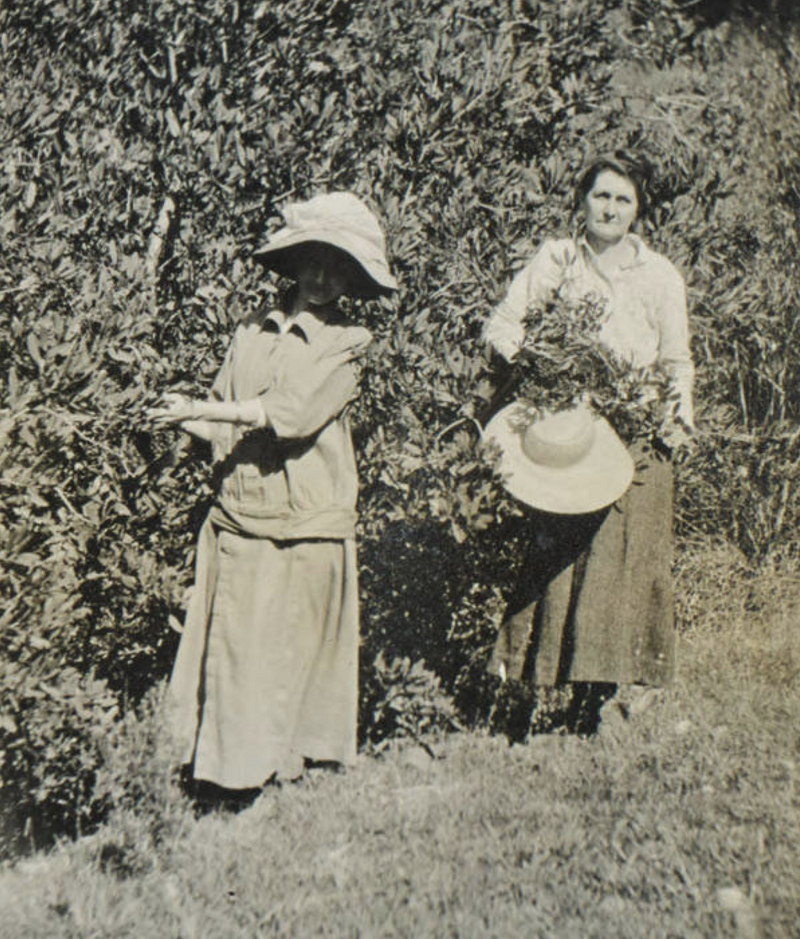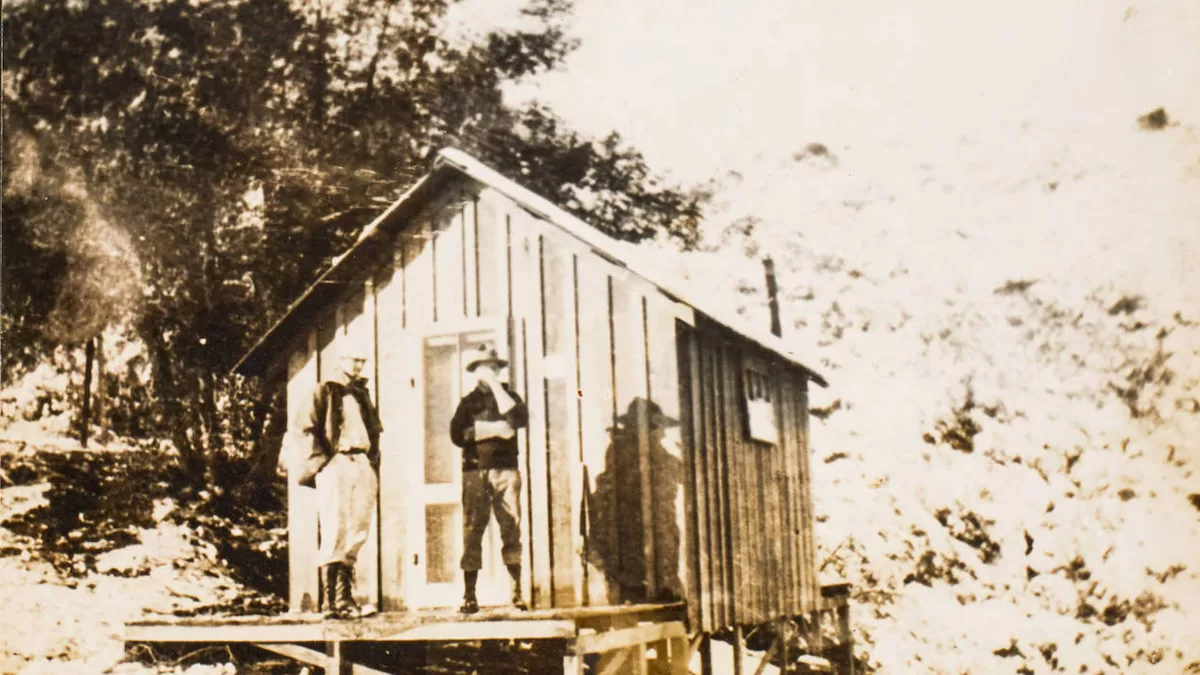
The earliest written account of Christmas in the Santa Monica Mountains appears to be one published by Frederick Hastings Rindge in his 1895 book, Happy Days in Southern California.
Rindge describes his ranch house in Malibu festively decorated with boughs and wreaths of toyon berry and the air of holiday anticipation within the walls of a household with young children in it.
“There are hurried footsteps in the morning, each hastening to be the first to bid ‘Merry Christmas’ to others,” Rindge writes. “There are interchanges of kind words and gifts, if the Christmas Eve tree has not done its duty the night before. There is the family worship and the singing of old Antioch and Hanover, those two old Christmas hymns so full of glory. Then there is the great Christmastide fire, in the broad and deep fireplace; a real Christmas fire, crackling and roaring in gladness as it offers its tribute of holiday cheer, around which we gather after a happy dinner of a home-fattened turkey, that had unconsciously been preparing himself for us during a fortnight, to keep company with the cranberries from Cape Cod. How proud a man is to dine off what he himself raises!”
Although the simple pleasures Rindge describes would have been shared by many of his neighbors, he wasn’t a typical settler. A wealthy New England philanthropist and industrialist, Rindge purchased the entire Topanga Malibu Sequit Rancho—more than 14,000 acres—in 1892. He was a poet and a romantic, as well as a canny businessman, and his writings reveal a deep love for the wild beauty of the Santa Monica Mountains. His book is also a real estate infomercial for East Coasters, and a new flood of settlers was about to arrive in the Santa Monica Mountains, but not the ones he was writing to encourage. This wave of new arrivals weren’t gentleman farmers enticed by the promise of orange groves; they were homesteaders seeking to stake a small claim of their own.
In 1889, the federal Land Office in Los Angeles began to open the last “free” lands on the West Coast, including parts of the Santa Monica Mountains. In 1895, Congress passed a new act, making smaller sections of land available, generating a modest land rush in the Santa Monica Mountains.
Most homestead Christmas dinners in the Santa Monica Mountains at the time Rindge wrote about were more likely to feature beans—the main crop grown in the area—than imported cranberries. It was a tough life, but the homesteaders looked after each other.
Rindge describes filling Christmas baskets of food to carry on horseback “to the neighbor whose stores were scant.”
Scant was probably not an exaggeration. There was an extreme disparity between a family like the Rindges, with a mansion in town in addition to their rustic Malibu Rancho, and access to every modern convenience and luxury—from electricity and running water to automobiles and department stores—and the hardscrabble existence of homesteaders who often lived in rugged frontier conditions.
One of the characters Rindge describes in his book is an old man who lived in a cabin that was half cave at the back of a remote canyon and made a living foraging on the land. Rindge wrote that the man lived on five dollars a month, subsisting mostly on the beans that he grew and wild game.
We know from the oral accounts of former residents raised in areas like the Yerba Buena District at the western end of the Santa Monica Mountains recorded by the National Park Service that conditions were austere for many, with large families sharing one-room cabins, and amenities like running water an unimagined luxury. Families foraged for fuel and food, and carried water by the bucketful from unreliable creeks or brackish wells. Homesteaders had to make do with what they had on hand or could pick up on infrequent trips into town. In the Yerba Buena District at the western end of the Santa Monica Mountains, settlers made the perilous trip down from the mountain to buy dry goods and staples like flour and sugar only a few times a year.
Yerba Buena homesteader Lauretta Houston’s children remember her as an adventurous horsewoman who often made the two day trip to collect the mail for the community, and made sure the children had Christmas treats like penny candy. The Houston family always transported their piano—the only one on the mountain—down to the one-room Decker school house at Christmas to provide music for holiday festivities.
In Topanga, families also gathered at the school house. A 1907 article entitled “Quaint Life of Topango Canyon,” written by Cloudsley Johns for the Los Angeles Times, describes monthly assemblies when “the dwellers in the canyon gather in the Garrapatos schoolhouse to show what each can do to amuse the others.”
The night of the full moon was always chosen, Johns wrote, to enable the merry-makers to return safely home on the narrow mountain roads. It’s easy to imagine the settlers described by Johns—including the 17 Santa Maria family children—celebrating the holidays with music and dancing.
The earlier generation of settlers during the Spanish and Mexican period celebrated Christmas with fiestas that brought extended families together for weeks at a time, and there were still families in the Topanga and Pacific Palisades areas that would have continued to honor earlier traditions, although perhaps not with all of the accompaniments included in one of the earliest descriptions of Christmas in Los Angeles. In 1855, the Los Angeles Star described: “bull fights, bell ringing, firing of crackers, fiestas and fandangos,” together with, “dancing and feasting, and gymnastic exercises continued till morning,” and notes that “cascarones [hollowed out egg shells filled with confetti] commanded a premium,” and “many were complimented with them as a finishing touch to their head dress.”
Topanga settlers had an easier time getting supplies from town and transporting goods to market than mountain settlers in more remote areas. Civilization was a three-hour ride from the heart of the canyon, as opposed to a whole day’s journey or possibly two, depending on the tides along the coast route. Car culture arrived early in the canyon, increasing access to town at a time when Yerba Buena settlers still had to depend on horses, mules or foot. Topanga Canyon Blvd., fully paved from coast to valley in 1915, meant electricity arrived earlier than it did in other parts of the mountains. Year-round water also helped support a more robust community and more diverse crops in Topanga, but it was still a very different life from that of more urban communities just a few miles down the mountain.

Christmas trees became fashionable in Los Angeles in the 1850s, well before most American homesteaders staked a claim in the local mountains. Christmas decorations, including rows of trees covered in electric light bulbs (invented in 1882, and already wildly popular by 1900) and windows with fanciful holiday displays at stores like the Boston Dry Goods Store on North Spring Street (it would later evolve into Robinson’s), and Henshey’s in Santa Monica (which opened in 1925) must have been a revelation to homesteaders on a rare trip into town.
Johns’ article states that “almost everyone” in the canyon raised chickens, ducks and turkeys, some also kept goats, and others tended bees and sold honey. A 1910 Los Angeles Times article describes a special variety of apple grown in the canyon, Beitgheimer, “handsome in appearance and very fragrant.” Lille Svenson planted four acres of grape vines and became locally famous for the grapes she grew. The Greenleaf family grew Bartlett pears. There would have been more than just beans at a Topanga homestead holiday dinner.

In addition to selling produce and honey in town, Topanga homesteaders foraged for firewood and cut boughs of California bay and toyon berries that they sold in town for holiday decorations. Photos taken by Topanga School Teacher Theresa Sletton, c. 1915, show some of her friends gathering branches of toyon. This welcome addition to household income came at a price. The berries were in such demand for decorations that the toyon came perilously close to being loved to extinction.
A photo album that belonged to longtime Topanga resident Robert Hutton as a young man includes images from Christmas a few years later that reveal a world that looks more like the 19th century than the 20th. Hutton, a senior at Santa Monica High School, snapped photos of himself and his friends climbing Topanga’s distinctive rock formations, posing in ten gallon hats with six shooters, and reclining in front of a tiny cabin during Christmas vacation in 1917, but life for even the most remote homesteaders was changing fast.
Radio provided a connection to the outside world long before TV or the internet, and catalogs, like the one from Sears, fueled dreams of holiday treats far exceeding the delights of penny candy.
It wasn’t until the 1940s that the more remote corners of the Santa Monica Mountains fully caught up with the 20th century—some longtime residents still remember shared phone lines and plenty of residents still operate on wells and propane.
Today, we embrace more holidays and customs than previous generations could have imagined, but this is still a community that embraces peace and goodwill and kindness to neighbors and strangers, as well as for friends and family. For many of us, the blessings of the season continue to be rooted in the beauty and tranquility of our mountains.




